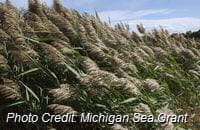--- third and last in a series ---
In The Voice, October 2, 2014, Jim Bloch wrote a story titled, “Written off as doomed, native mussels survive zebra mussel invasion.” Excerpts:
“The causes of the decline and extinction of fresh water mussels are among the same conditions that led the St. Clair River to be classified as an environmental area of concern in 1985: Habitat destruction, pollution, commercial exploitation and invasive species.
 |
| Lake St. Clair and delta |
“In the case of the Great Lakes, invasive species in the form of zebra mussels and quagga mussels came close to wiping out native mussels, already in a perilous state when the invaders arrived in the late 1980s and early 1990s.
“ ‘Come the late 1980s and early 1990s, all the native mussel populations crashed in Lake St. Clair, Lake Erie and the Great Lakes in general,’ said [Dr. David T.] Zanatta.”
“Average density of native mussels before the arrival of zebra mussels was two per square meter in Lake St. Clair. By 1990, zebra mussel density was at 1,600 per square meter.”
“By 1994, there were almost no native mussels left in the lake, with zebra now at 3,000+ per square meter.”
“ ‘But there was reason for hope,’ said Zanatta. ‘Remnant populations of native mussels were beginning to be found in coastal wetlands in western Lake Erie in the late 1990s.’ ”
"In addition, zebra mussel populations started showing dramatic declines between 1994 and 2001 in Lake St. Clair, even though their sheer numbers remained staggering."
“ ‘In my master’s work, we found that there was a large native mussel refuge in the St. Clair Delta,’ said Zanatta, referring to samplings he participated in 1999-2001.”
“...’There are 37 species known historically from Lake St. Clair. We’ve recorded 22 species actually in the lake in the last decade despite all sorts of pretty negative impacts.’ ”
“In expanded research funded through the Great Lakes Restoration Initiative, Zanatta found that the St. Clair Delta and western Lake Erie ‘were the most healthy areas of the lakes in terms of native mussel abundances.’ “
*****
From the abstract of Distribution of native mussel (unionidae) assemblages in coastal areas of Lake Erie, Lake St. Clair, and connecting channels, twenty-five years after a dreissenid invasion, a journal article by David T. Zanatta, et al. published in 2015 (excerpts):
“Despite the invasion, unionids have survived in several areas in the presence of dreissenid mussels.”
 |
| Thompson Bay, Presque Isle, Pennsylvania |
“We...documented species abundance and diversity in coastal areas of lakes St. Clair and Erie. The highest-quality assemblages of native mussels (densities, richness, and diversity) appear to be concentrated in the St. Clair delta, where abundance continues to decline, as well as in in [sic] Thompson Bay of Presque Isle [Pennsylvania] in Lake Erie and in just a few coastal wetlands and drowned river-mouths in the western basin of Lake Erie. The discovery of several new refuge areas suggests that unionids have a broader distribution within the region than previously thought.”
*****
From the abstract of Characteristics of a refuge for native freshwater mussels (Bivalvia: Unionidae) in Lake St. Clair, a journal article by D.J. McGoldrick, et al., last updated January 29, 2016 (excerpts):
“The Lake St. Clair delta ... provides an important refuge for native freshwater mussels (Unionidae) wherein 22 of the ~35 historical species co-occur with invasive dreissenids.”
“Zebra mussel infestation of unionids in the delta appears to be mitigated by dominant offshore currents, which limit densities of zebra mussel veligers [planktonic larvae] in nearshore compared to offshore waters …”
“Glycogen concentrations in the tissues of a common and widespread species in the delta (Lampsilis siliquoidea) suggest that zebra mussels may be adversely affecting physiological condition of unionids in a portion of the Lake St. Clair delta. Physiological condition and community structure of unionids within the delta may also be influenced by differences in food quantity and quality resulting from the uneven distribution of water flowing from the St. Clair River. The delta likely supports the largest living unionid [?] includes several species that have been listed as Endangered or Threatened in Canada and/or the state of Michigan, making it an important refuge for the conservation of native unionids.”
*****
 |
| Round Goby |
Why no mention, you might ask, of quagga mussels? Don’t know. Maybe Lake St. Clair and the delta are too warm and shallow for them.
And why haven’t the zebras wiped out the bottom of the food web in Lake St. Clair, as the quaggas have done in lakes Huron and Michigan? Possibly the abundance of nutrients like phosphorus in Lake St. Clair (and western Lake Erie) can produce phytoplankton such as algae faster than the zebras can devour it, leaving plenty for tiny animals that become food for an invasive fish, the round goby, now thriving and the favorite prey of some of the popular game fish in Lake St. Clair.
In any event, this saga is far from over. The balance will work out over decades, altered from time to time by further agents of change.




